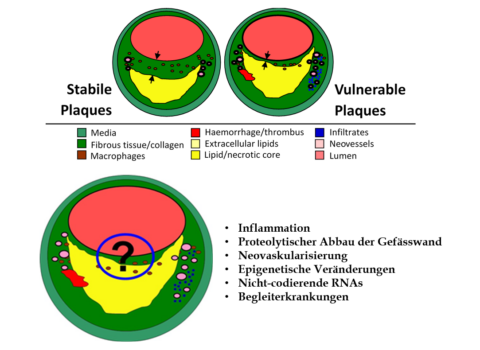Vulnerable carotid plaques and ischemic stroke
In spite of decade-long intensive research in the field of cardiovascular disease the underlying pathophysiological mechanisms leading to the formation and progression of atherosclerosis has not yet completely elucidated.
In particular, the biological processes and factors responsible for vulnerable/unstable atherosclerotic plaques that in case of carotid arteries cause frequently ischemic stroke.

The aim of our experimental research is therefore a better understanding of the pathophysiological processes leading to plaque vulnerability in patients with high-grade carotid artery stenosis, in order to be able to develop novel and more reliable diagnostic and therapeutic strategies.
We re using and analysing carotid plaques in different stages of atherosclerosis employing our Swiss Vascular Biobank (SVB) and Munich Vascular Biobank (MVB) in collaboration with the Department of Vascular and Endovascular Surgery of TU Munich (Prof Eckstein, Prof Maegdefessel). For these purposes, we apply the state-of-the-art molecular-biological techniques such as transcriptome and proteome analyses, focusing on epigenetic changes and non-coding RNAs (lncRNAs, circRNAs) in different stages of atherosclerosis. These results are validated by standard methods such as immunohistochemistry, qRT-PCR, western blotting and others.
- Xu S, Xu Y, Liu P, Zhang S, Liu H, Slavin S, Kumar S, Koroleva M, Luo J, Wu X, Rahman A, Pelisek J, Jo H, Si S, Miller CL, Jin ZG. The novel coronary artery disease risk gene JCAD/KIAA1462 promotes endothelial dysfunction and atherosclerosis. Eur Heart J. 2019;25(3):529.
- Cochain C, Vafadarnejad E, Arampatzi P, Pelisek J, Holger C, Klaus D, Wolf D, Saliba AE, Zernecke A. Single-cell RNA-seq reveals the transcriptional landscape and heterogeneity of aortic macrophages in murine atherosclerosis. Circ Res. 2018;122(12):1661-1674.
- Jin H, Li DY, Chernogubova E, Sun C, Busch A, Eken SM, Saliba-Gustafsson P, Winter H, Winski G, Raaz U, Schellinger IN, Simon N, Hegenloh R, Matic LP, Jagodic M, Ehrenborg E, Pelisek J, Eckstein HH, Hedin U, Backlund A, Maegdefessel L. Local Delivery of miR-21 Stabilizes Fibrous Caps in Vulnerable Atherosclerotic Lesions. Mol Ther. 2018;26(4):1040-1055.
- Merckelbach S, van der Vorst EPC, Kallmayer M, Rischpler C, Burgkart R, Döring Y, de Borst GJ, Schwaiger M, Eckstein HH, Weber C, Pelisek J. Expression and Cellular Localization of CXCR4 and CXCL12 in Human Carotid Atherosclerotic Plaques. Thromb Haemost. 2018;118(1):195-206.
- Pelisek J, Deutsch L, Ansel A, Rudelius M, Pongratz J, Stadlbauer T, Gebhard H, Eckstein HH. Expression of a metalloproteinase family of ADAMTS in human vulnerable carotid lesions: implication for clinical practice. J Cardiovasc Med. 2017;18(1):10-18.
- Eken SM, Jin H, Chernogubova E, Li Y, Simon N, Sun C, Korzunowicz G, Busch A, Bäcklund A, Österholm C, Razuvaev A, Renné T, Eckstein HH, Pelisek J, Eriksson P, Gonzalez Diez M, Matic Perisic LP, Schellinger IN, Raaz U, Leeper NJ, Hansson GK, Paulsson-Berne G, Hedin U, Maegdefessel L. MicroRNA-210 Enhances Fibrous Cap Stability in Advanced Atherosclerotic Lesions. Circ Res. 2017;120(4):633-644.
- Hyafil F, Pelisek J, Laitinen I, Schottelius M, Mohring M, Döring Y, Van der Vorst E, Kallmayer M, Steiger K, Poschenrieder A, Notni J, Fischer J, Baumgartner C, Rischpler C, Nekolla S, Weber C, Eckstein HH, Wester HJ, Schwaiger M. Imaging the cytokine receptor CXCR4 in atherosclerotic plaques with the radiotracer 68Ga-pentixafor for positron emission tomography. J Nucl Med. 2017;58(3):499-506.
- Pelisek J, Wendorff C, Wendorff H, Kuehnl A, Eckstein HH. Age-associated changes in human carotid atherosclerotic plaques. Annals of Med. 2016;48(7):541-551.
- Cochain C, Koch M, Chaudhari SM, Busch M, Pelisek J, Boon L, Zernecke A. CD8+ T Cells Regulate Monopoiesis and Circulating Ly6Chigh Monocyte Levels in Atherosclerosis in Mice. Circ Res. 2015; 117(3):244-53.
- Wendorff C, Wendorff H, Pelisek J, Tsantilas P, Zimmermann A, Zernecke A, Kuehnl A, Eckstein HH. Carotid plaque morphology is significantly associated with sex, age and history of neurological symptoms – Results from the Munich Vascular Biobank – Stroke. 2015;46(11):3213-9.
- Chaudhari S, Sluimer J, Koch M, Theelen T, Manthey H, Busch M, Caballero-Franco C, Cochain C, Pelisek J, Daemen M, Lutz M, Gorlach A, Kissler S, Hermanns H, Zernecke A. Deficiency of HIF1alpha in antigen-presenting cells aggravates atherosclerosis and type 1 T helper cell responses in mice. Arterioscler Thromb Vasc Biol. 2015;35(11):2316-2325.
- Pelisek J, Pongratz J, Deutsch L, Reeps C, Stadlbauer T, Eckstein HH. Expression and cellular localisation of metalloproteases ADAMs in high graded carotid artery lesions. Scand J Clin Lab Invest. 2012;72:648-656.
- Pelisek J, Reeps C, Ockert S, Zimmermann A, Zepper P, Poppert H, Eckstein HH. Evaluation of serum biomarkers for patients at increased risk of stroke. Int J Vasc Med. 2012:906954.
- Pelisek J, Well G, Reeps C, Poppert H, Kuehnl A, Baumann M, Heemann U, Eckstein HH. Neovascularisation and angiogenic factors in advanced human carotid artery stenosis. Circulation J. 2012;76(5):1274-1282.
- Stolla M. Pelisek J, von Brühl, ML, Schäfer A, Heider P, Barocke V, Lorenz M, Tirniceriu A, Steinhart A, Bauersachs J, Bray PF, Massberg S, Schulz C. Fractalkine is Expressed in Early and Advanced Atherosclerotic Lesions and Directly Supports Monocyte Recruitment via CX3CR1. PLoS ONE, 2012;7(8):e43572.
- Heider P, Pelisek J, Poppert H, Eckstein HH. Evaluation of serum matrix metalloproteinases and serological factors as biomarkers for detection of neurological symptoms. Vasc Endovasc Surg. 2009;43(6):551-60.
- Pelisek J, Rudelius M, Zepper P, Schuster T, Seidl S, Reeps C, Zimmermann A, Poppert H, Eckstein HH. Multiple biological predictors for vulnerable carotid lesions. Cerebrovasc Diseases. 2009;28(6):601-610.